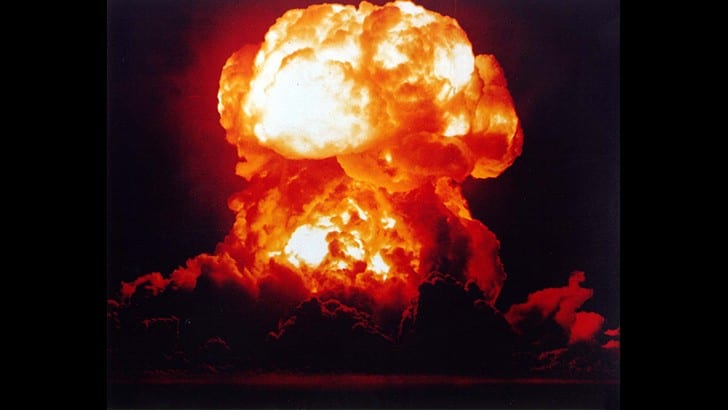
News weekly feels the threat of cataclysmic war is grave enough to warrant direct action
January 30, 2018
BY JASON PRAMAS @JASONPRAMAS
DigBoston—and this should be obvious, but it bears stating plainly—is against the US or any nation, organization, or individual having nuclear weapons. Because the longer anyone has them, the more likely it is that they will be used. And if one is used, there is a very significant chance that many or even all of the nukes will be used. Lest we forget that when the US had the first two atomic bombs in existence, and used one, it was very quick to use the second.
That’s why last week, the Bulletin of the Atomic Scientists, a journal founded in 1945 by Manhattan Project scientists who “could not remain aloof to the consequences of their work,” moved the hands of its famed “Doomsday Clock” up from “two and a half minutes to midnight” to “two minutes to midnight.” The clock has not been so close to “midnight”—meaning nuclear war—since 1953. Shortly after both the US and the former Soviet Union tested their first outrageously destructive hydrogen bombs at the height of the Cold War.
The journal’s reasons for taking this alarming step are many, and can be read on its website, thebulletin.org. But at base, it is dangerous changes to US nuclear policy under Presidents Barack Obama and Donald Trump that threaten to overturn treaties that have led to decades of reductions to the global stockpile of nuclear warheads—from over 65,000 in 1986 to about 15,000 today—coupled with Trump’s escalating war of words with North Korea’s Kim Jong Un that led to the clock being dialed forward.
Behind the bluster is the world’s largest military: America’s. Which for the last few months has been positioning conventional and nuclear forces within easy striking distance of North Korea. So when, according to the Wall Street Journal, some of the less sane Trump administration figures like National Security Advisor H.R. McMaster support the idea of giving the growing North Korean nuclear weapons program “a bloody nose” with a military strike using “small,” “tactical” nuclear weapons, the world takes notice. And the Doomsday Clock continues its unnerving march toward midnight.
Lest readers think such concern is overstated, Business Insider just reported that the US has deployed B-2 stealth bombers to Guam—joining B-52 bombers already stationed there. Both planes are capable of delivering nuclear weapons. Including the new B61-12 gravity bombs that, while not slated to be deployed until 2019, are supposedly able to take out deep bunkers with a minimum of damage and fallout. Which, together with their adjustable yield setting down to a fraction of the Hiroshima bomb, makes them more likely to be used, according to peace activists and defense officials alike. And a fraction of a bomb that destroyed and irradiated an entire city is still much more dangerous than the largest US conventional weapons. Not to mention the Pandora’s box problem. Since once the US opens that figurative box by using nukes in battle, there’s nothing to stop other countries from doing the same. Least of all North Korea.
Russia and China have been frantically trying to get the US to pursue a diplomatic path to peace with North Korea, but to no avail. At a time when the US no longer has any nuclear disarmament negotiations in progress with Russia, a nation with 7,000 nuclear warheads—the most of any nation—and tensions are rising with China, which has 270 warheads, that is most disturbing news indeed.
Because the path from the “bloody nose” of a few “smaller” nukes like the B61-12 dropped on North Korean nuclear weapons sites—or sites that Pentagon planners assume are nuclear weapons sites despite having been wrong before due to poor intelligence on North Korea—to a global conflagration is crystal clear. Since the ironically named “Demilitarized Zone” between North and South Korea is the most heavily fortified place in the world. And 35 miles south of the zone is Seoul, the capital of South Korea.
If the US nukes North Korea, then Kim Jong Un would have every reason to nuke American targets that North Korean missiles are probably capable of reaching in the Pacific basin—and even Seoul itself in retaliation. Followed by other nuclear strikes, using precisely the same “use ’em or lose ’em” strategy that the US has followed since the dawn of the Atomic Age, according to Daniel Ellsberg—who recently released a book about his decade as a senior American nuclear strategist prior to his leaking the Pentagon Papers and helping end the Vietnam War.
Once nukes are flying, therefore, there’s nowhere to go but down. North Korea has somewhere between 10 and 60 warheads—depending on whether you believe the lower estimates by peace groups like the Nobel Prize-winning International Campaign to Abolish Nuclear Weapons or the higher estimates by US government sources—and its quest to figure out how to miniaturize nukes to fit on its short-, medium-, and now long-range missiles has been a precipitating factor in the current crisis. The US, for its part, has about 6,800 warheads overall. About 1,800 of which are deployed, according to 2017 data from the Federation of American Scientists.
The American military would be dropping nukes on direct orders from a president with all the powers of his predecessors to use them at will with no check from any other branch of government. The weapons would strike a very small country that shares borders with Russia and China—two rival superpowers with huge armies and thousands more nuclear weapons between them. A couple of miscalculations involving unexpected fallout yield or an errant strike due to a jammed guidance system or any number of other unforeseen occurrences with incredibly dangerous nukes and it’s bye-bye Vladivostok and adieu Yanbian.
An unauthorized US flyover of Russia or China or the entry of a US fleet to their territorial waters during attacks on North Korea could also result in a nuclear response from either country—especially should the US lower the bar and start using nukes in combat again. And North Korea, with nuclear weapons that are hardly the most accurate or stable, could easily make mistakes that would draw Russia or China into a shooting war. Even though North Korea has stated that it is “only” targeting the US with nukes, according to Newsweek. The possibilities for error are endless in a conventional war, let alone one involving nuclear exchanges. So it’s easy to see how any use of horrific weapons of mass destruction can quickly put the entire world on the fast track to Armageddon.
For these reasons, and many more besides, DigBoston cannot stand on the sidelines and remain silent while the threat of a war that would exterminate the human race rises by the day. To do so would be an abrogation of our moral and ethical responsibilities—not only as journalists, but as human beings.
And if the planet is destroyed, journalists like us aren’t going to be able to report the news anymore, now are we? Nor will our audience have any use for it in the hereafter.
As such, this publication is joining the swiftly reviving movement to abolish nuclear weapons.
We plan to participate in the following ways:
- Open our pages wide to opinion articles calling for the abolition of nuclear weapons, as we continue to editorialize about same.
- Produce an ongoing series of columns, features, and investigative reports in the public interest exposing Massachusetts institutions involved in developing, producing, and/or profiting from nuclear weapons.
- Work directly on campaigns to abolish nuclear weapons with local, national, and international peace organizations—adding the name of our publication to the growing list of civic, social, religious, professional, and business organizations in tandem with the 56 nations that have already signed the new UN Treaty on the Prohibition of Nuclear Weapons in saying that the only sane nuclear weapons policy is to mandate a world without such weapons.
- Help organize our colleagues in the news industry to join us in the fight to abolish nuclear weapons.
We’ll talk about more specifics over the coming months, but anyone with questions about our stance is welcome to email us at editorial@digboston.com.
Jason Pramas is executive editor and associate publisher of DigBoston.

